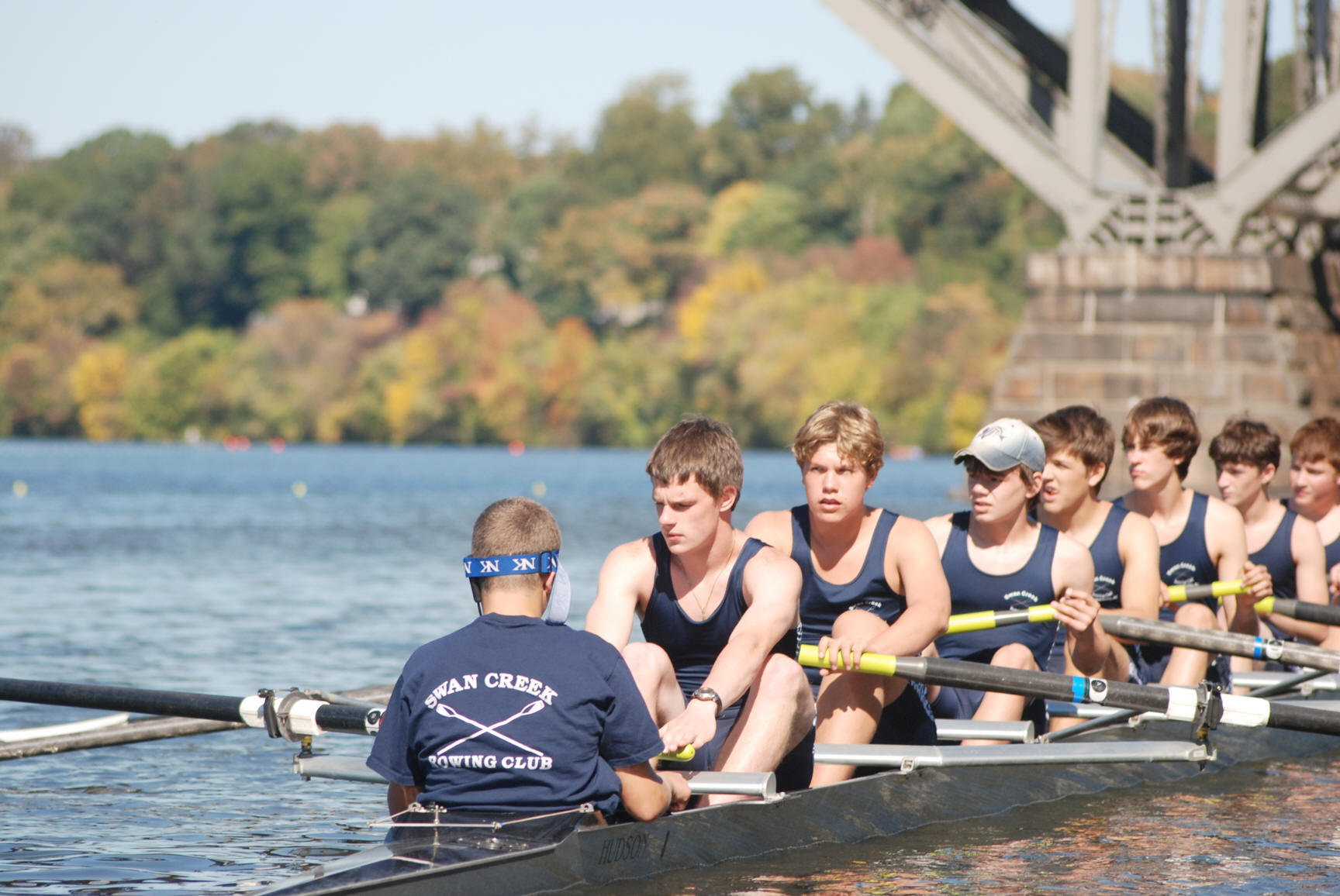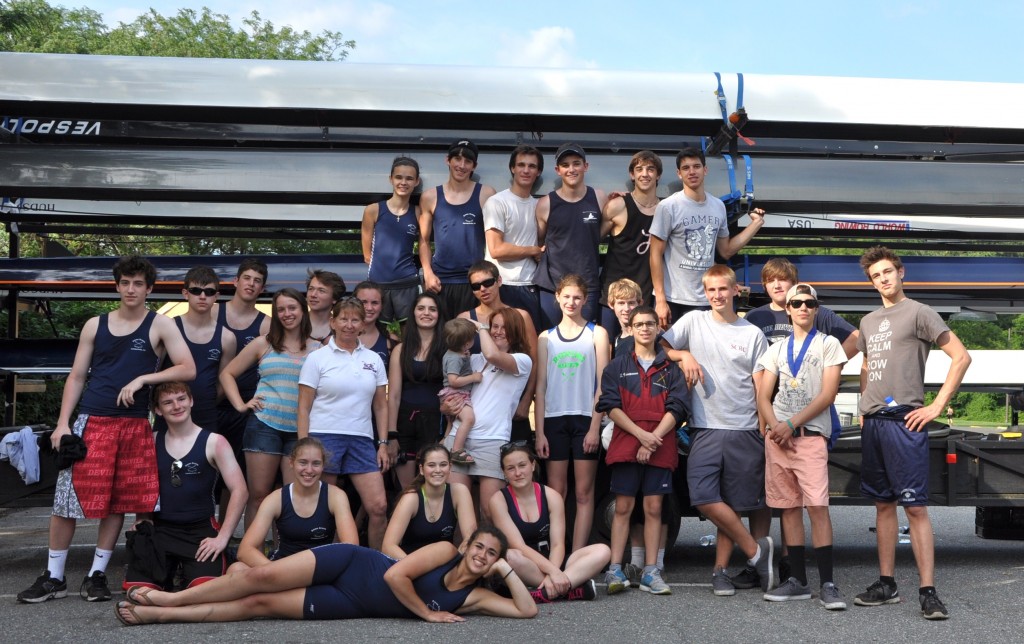Swan Creek Rowing Club Youth Team and Program
Welcome to Swan Creek Youth program and team, an active component of the Swan Creek Rowing Club.
The Learn-To-Row program is held annually in August and January, there are two camps. For more info please visit our Youth Learn to Row page. Our experienced team members may train year-round.
Swan Creek youth learn and refine rowing skills, develop teamwork and a respect for the water. Rowing is deceiving because those who do it well make it look easy, yet it is a fun way to increase fitness! Rowing is a total body workout, combining cardiovascular efficiency, power, coordination and mental toughness. It is an endurance sport and is low-impact on the joints. The best rowers bring a positive attitude and self-motivation to the team.

No sport teaches greater lessons of teamwork and no sport shows a greater direct relationship between hard work and results. Rowers look fit because they are.
Almost all of our competitive members started at Swan Creek Rowing Club (Club) as novices, so experience is not a pre-requisite. Our youth group Learn To Row (LTR) program was started in 2000. There is also opportunity to learn through individual lessons, although we recommend the group program because it’s more fun and a better way to understand the teamwork inherent in crew.
On the other hand, if you have rowed before and are looking for a challenge, we have motivated team members who train hard under excellent coaches and win medals in sprints, regattas and erg competitions.
In addition to rowers, the team welcomes girls or boys interested in becoming a coxswain (cox-in), the person in a four or eight who steers the boats and serves as the on-water coach, developing tactical and leadership skills. Youth who solely act as coxswains don’t pay the annual youth Club membership fee.
Practices
Like any sports team at the high school level, attendance at practices is important. Rowers must be prompt – otherwise the boat will leave without you, or won’t be able to leave at all – and prepared to work hard.
We train on the scenic Delaware River, weather permitting, from early or mid spring through the end of October. A typical practice from the boat site, south of the Swan Creek in Lambertville, includes stretching exercises, running on the adjacent towpath and rowing on the river. Learn To Row and team members must be able to safely access and easily seat themselves in the boat, either from the water (at practices) or a dock (at races).
For practices from the site, rowers in warm weather wear T-shirts or spandex tops. Boys and girls were spandex rowing shorts (which won’t catch on boat slides) under gym shorts (worn when running or stretching out). Sneakers are required for running and water shoes for entering the river. Socks are worn in the boats. Water bottles should be brought to each practice. There is a public restroom adjoining the site. In spring and fall, tights, thermal tops and wool socks may be necessary.
Indoor team winter workouts are available three times weekly, with weekend open times optional. In winter the workouts are on the ergs, with stretching, strength and conditioning exercises. Erg workouts are very important because the simulated rowing motion prepares athletes for seasonal races. Additionally, timed erg test results are vital for athletes planning to seek a seat on a college crew.
Preparing for Collegiate Crew
 Swan Creek Youth Team members who train year-round are not only competitive in races against their peers, they are prepared for the rigor of collegiate play.
Swan Creek Youth Team members who train year-round are not only competitive in races against their peers, they are prepared for the rigor of collegiate play.
If you’re looking for a collegiate sport you have a lot of options with crew: at least 140 women’s Division I, II or III teams and 50 clubs and 65 men’s Division teams and 67 clubs.
Competition
Team members compete in late spring/summer and fall races and at winter erg competitions. Our region is rich with regattas, particularly in the Philadelphia area. Occasionally we travel overnight.
Hard, consistent effort is rewarded with entries in regattas. This is a sport that defines teamwork while allowing each member to shine – winning boats have at most nine people in them, eight rowers and a coxswain.
The coaches decide which boats will compete, and seat placement. The most competitive boats consist of athletes who align work ethic, talent and training. Athletes may ask the coaches about seat or boat placement, parents may not.
Boys and girls compete separately. In addition, some events offer separate competitions for lightweight and open weight athletes.
Swan Creek youth compete in junior events, for those age 18 or younger or who have spent their previous year in high school. Our team is not allowed to compete in scholastic events because we draw members from a number of public and private high schools. Our athletes have come from Hunterdon, Mercer and Somerset counties in New Jersey and Bucks County in Pennsylvania.
Rowing Terms

There are two basic types of rowing: sweep, in which athletes hold one oar with two hands and sculling, in which they hold two oars. Initially, youth learn to sweep in eight-man boats, which are more stable. As they gain experience, team members may row in fours or pairs. The Club and youth program also offer sculling instruction. Scullers may row in quads, doubles or a single.
The person sitting in the bow, the end of the shell that crosses the finish line first, is called the bow or No. 1 seat. The next is No. 2 and so on. The rower closest to the stern end, which crosses the finish line last, is known as the stroke. The stroke sets the boat’s rhythm and must have strength and top-notch skills.
Safety Precautions
Safety is important and is something we’re conscious of at all times. Youth rowers must pass a swim test with a certified instructor before they are boated. Every year all youth view a rowing‐specific safety video. Safety vests interfere with the rowing motion and are not worn by LTR or experienced youth. Boats are rarely flipped, but when that happens athletes are expected to use the shell for support, then to right the shell and regain their seats. They are shown how to do this by the coaches as part of the training program.
Coaches accompany LTR and experienced team members at practices aboard a motorized launch. Equipped with a megaphone, this allows them to instruct LTR and team members. The launch also allows coaches to pull a rower from the water who may have difficulty regaining his or her seat in the rowing boat. Further, the Club has a flag system based upon river conditions, including temperature, river flow and debris. LTR youth are only allowed on the water under a green flag, considered optimal conditions.
Experienced youth row outside of coach‐supervised training time once approved by the coaches and Club, following Club rules.


